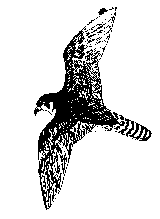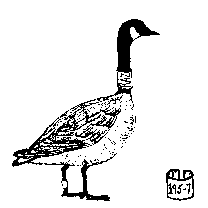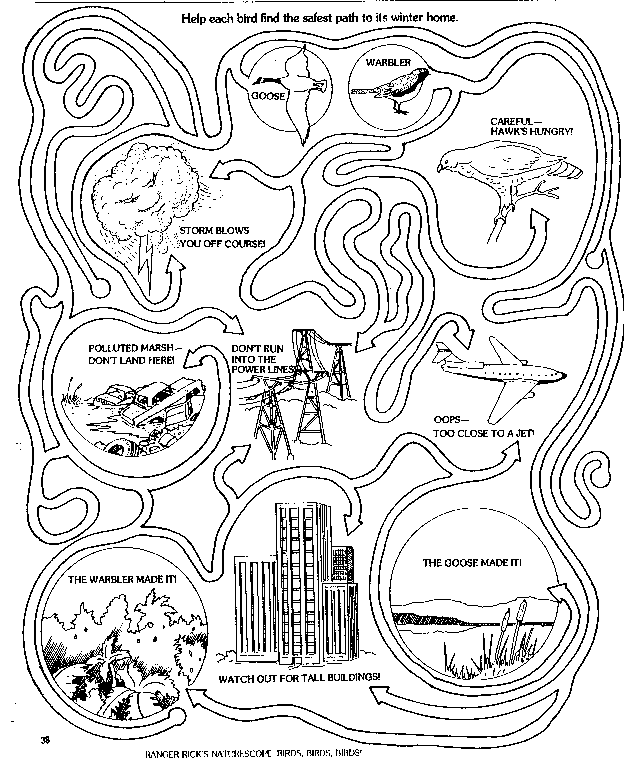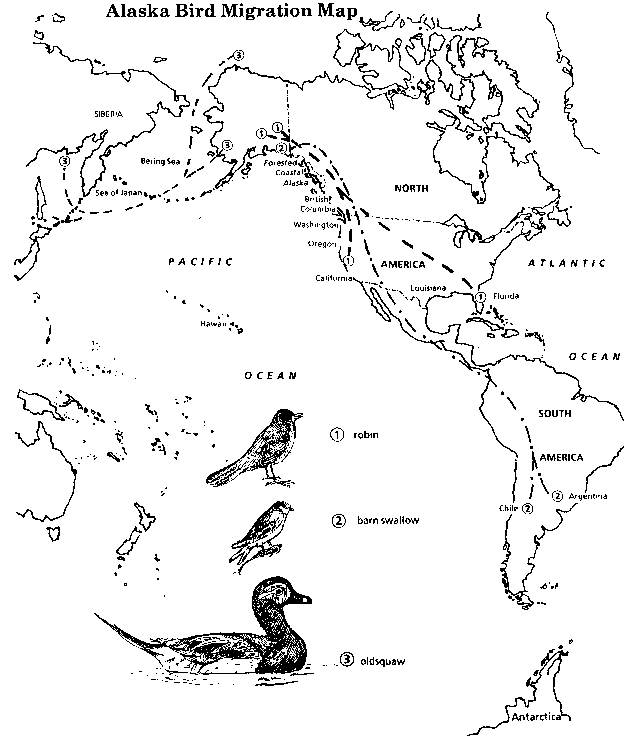Lessons & Units
A database
of lessons and units searchable by content and cultural standards,
cultural region and grade level. More units will be available soon.
You can use Acrobat Reader to look at the PDF version of the Cover
Sheet
for the Units and Self-Assessment
for Cultural Standards in Practice.
BIRDS
Lesson 5
Seasons and Bird Migration
Objectives:
1) Students will describe
what is meant by migration and tell the destination and
distance traveled by some of the local birds.
2) Students will list which birds are common
around the village in each season of the year.
Activities:
1) Discuss the meaning of "migration".
Why do birds migrate? Study migration maps as available. Map migration
patterns for several local birds. (Alaska's Birds, pg. 70-73; "Alaska Bird Migration
Map")
2) List the dangers birds may face during
their long journeys. Do the "Copycat Page - Migration Maze". Make
your own maze.
3) Do "Migration Math Magic" or a similar
math activity. Then using your maps for local birds, calculate
how far some of the birds travel from your area.
4) Using the bird list made in Lesson 2,
decide in which of the 4 seasons each bird is found locally.
Are they permanent residents, summer residents or birds just
passing through in fall and spring? Illustrate this information
with a chart.
Additional Resources:
"White Fronted Geese" from Facts About Geese
(in the Appendix) "Migrating with the Birds" from Teach About
Geese (in the Appendix) "An Incredible Journey" by Kate Perry,
from Amazing Worlds magazine BIRDS, pg. 8-11
Video: Monty the Moose- section
on migration
from ALASKA'S BIRDS
BIRD
MIGRATION
Bird migration is one of the
most fascinating and mystifying of natural occurrences. Of 325
regularly occurring birds in Alaska, over two-thirds migrate. Some,
like willow ptarmigan, migrate only a few miles from mountain tops to
more sheltered subalpine or forest areas. Other birds migrate
thousands of miles. Arctic terns are the long distance migration
champions; they migrate south from nesting areas at the northernmost
tip of the United States--Barrow, Alaska--to winter in Antarctica,
some 10,000 miles south. Each spring they return to Alaska, thus,
making an annual trip of 20,000 miles. Even Alaska's smallest birds,
rufous hummingbirds, migrate over 1,000 miles to winter in California
and Mexico. All of Alaska's tiny warblers migrate long distances,
too. Blackpoll warblers migrate to South America for the winter.
Townsend's warblers winter along the west coast of North America from
California to Central America, and wilson's warblers make a long
journey to Mexico and Central America. Several small Alaskan birds
including the arctic warbler, yellow wagtail, and bluethroat migrate
to Asia to winter. Golden plovers head to Hawaii and the West Indies,
while the bar-tailed godwit migrates to the south Pacific. Most of
Alaska's waterfowl head to the central valley of California or parts
of Mexico, although the eiders, oldsquaw, scoters, scaups, and some
other diving ducks spend their winter off the southern coasts of
Alaska.
What causes birds to migrate?
Clearly, birds leave Alaska in winter to visit places where the
winter weather is warmer, water is open, and food, particularly
insects, is more available. But most birds begin migrating south
before the temperature drops or food is scarce. In addition, the 100
plus species that remain in Alaska during winter never get the urge
to migrate. As a general rule, birds from the far north "leapfrog" past birds
of their own species during migration to winter in areas farther south; thus,
they travel farther than seems necessary to find
better weather and food.
Scientists have found that in
most birds the urge to migrate is caused by changes in day length.
However, some birds like crossbills and waxwings migrate in some
years but not others. Apparently, these birds get the urge to migrate
only when the weather is exceptionally cold or food is
scarce.
For many years, biologists have
been trying to figure out how birds are able to find their way during
migration. Different birds seem to use different methods, and even an
individual bird may use different methods under different weather
conditions or in different areas. Many birds use the moon, sun, and
stars to find their way. Scientists have found that birds will try to
migrate in the wrong direction in a planetarium if the pattern of
sun, stars, and moon in the planetarium sky are changed. Many birds
follow mountain ranges, sea coasts, and rivers during
migration.

This map shows some of the bird
migration routes from Alaska to other parts of the world. Can you
name a bird that follows each route?
1. Semipalmated sandpiper,
blackpoll warbler
2. Sandhill crane, peregrine
falcon, some dabbling ducks
3. Swainson's hawk, buff-breasted
sandpiper, violet-green swallow, western wood peewee, yellow
warbler, Wilson's warbler
4. Northern pintail, mallard,
American wigeon, greater white-fronted goose, long-billed
dowitcher, tree swallow, orange-crowned warbler, yellow-rumped
warbler, rosy finch
5. Red-throated loon, arctic loon,
red-necked grebe, horned grebe
6. Arctic tern
7. Red phalarope, red-necked
phalarope, Leach's storm-petrel
8. Golden plover, wandering
tattler
9. Short-tailed
shearwater
10. Bar-tailed godwit,
bristle-thighed curlew
11. Wheatear, baird's sandpiper,
yellow wagtail, arctic warbler
When clouds and bad weather
obscure the sun, moon, stars, and landmarks, however, most birds are
still able to navigate accurately. Some birds are able to detect
changes in the earth's magnetic field and perhaps use this ability to
keep on course. Sunspots and radar, which affect magnetic fields, are
known to confuse some migrating birds. Other birds are able to detect
very low frequency sounds over long distances. Low-frequency sounds,
or infrasounds, are created by winds over mountain ranges and by
pounding surf along a shore; possibly birds use these infrasounds to
guide their migrations.
Most small birds like sparrows,
warblers, and thrushes migrate mainly at night and stop during the
day to feed and rest. Larger birds like raptors and herons often
migrate by day. Loons, geese, gulls, terns, and shorebirds migrate at
night and during the day. Most birds migrate at altitudes less than
7,000 feet, but migrating birds have been observed flying at
altitudes over 20,000 feet. Most birds migrate at about 18 to
50 miles per hour. Most small perching birds travel at 18 to
25 miles per hour, while ducks and geese travel at 35 to 60 miles per
hour. Migrating sandpipers have been clocked at 110 miles per hour,
although 50 to 60 miles per hour is probably their usual
speed.
|

|
Some birds
(passerines, shorebirds, ducks, and geese) migrate in
flocks, while other birds (particularly hawks and owls)
often make the trip alone. Some species will flock only with
other birds of the same species (waxwings, geese, and
cranes) while other birds (shorebirds, thrushes, and
warblers) may travel in flocks of mixed species. Flocking
provides protection against predators and possibly a better
chance of finding food, water, or cover.
|
Though birds may be able to
survive winter better or find better places to nest by migrating,
most migrations are difficult and hazardous journeys. During
migration, thousands of birds are killed by storms and by flying into
man-made obstructions like TV antennas, towers, skyscrapers, and
lighthouses. In addition, as habitat change occurs rapidly throughout
the world, migrating birds face more and more difficult times
locating safe places to stop over to feed and rest. Drainage of
potholes and marshes leaves migrating water birds without places to
stop, while many forest areas that were once used by warblers and
thrushes are now cities and farms with few trees.
|

|
Much of what is known
about migration has been learned by banding birds. Leg bands
with numbers are placed on birds so that individuals can be
identified. Birds that are banded on the breeding grounds
are recaptured during migration or on the wintering grounds
(or vice versa), and thus, we learn where different birds go
to nest and winter. Scientists have found that many birds go
to almost the exact same places each year to nest and often
go to the same wintering areas each year. In addition to leg
bands, scientists also use neck collars and tags and
sometimes dye birds' feathers so they can be identified from
a distance.
|
Since birds travel across
national and international boundaries, various agencies and treaties
are responsible for their protection. Within the United States, the
U.S. Fish and Wildlife Service protects migratory birds through
Federal laws. International treaties with Canada and Mexico offer
protection for some of the international travelers. By cooperating
with other countries, governments can work to ensure that bird
populations are carefully managed on both their nesting and wintering
grounds.
Birds are not the only animals
that migrate. Can you think of some others?*
|
Activities
1. Name some of Alaska's
resident bird species.
2. Find out when birds migrate through your
area. Go out on a night with a bright moon and
watch for birds flying across the moon. Other good
places to watch for migrations are along ridges,
coastlines, rivers and lakes, through mountain
passes, along peninsulas, and from island to
island.
3. Find out if anyone in your area bands birds.
If so, ask him or her to give your club a
presentation or find out if you could observe him
or her banding birds.
|
*caribou,
gray whales, humpback whales, salmon, and northern fur
seals
|
Copycat Page
|
Migration Maze
|
|

from BIRDS AND WETLANDS OF ALASKA

from SHOREBIRDS OF THE PACIFIC FLYWAY
Do It!
Migration Math Madness
Objectives: Learn about the speeds
and distances that shorebirds fly by making
calculations. Become familiar with the geography of the Pacific
Flyway.
Skills: Measuring, recording data,
comparing, relating numbers to real events, multiplication
Subjects: Math, science,
geography
Topics: Migration, mileage, maps
Grade Levels: 1-9
Setting: Classroom
Materials:
Strings 20 cm long
(1/student or group)
Marking pens or crayons
Migration Math Maps for everyone
Before you begin your calculations, be sure to
read the student page called Migration Math Madness.
Procedure:
1. Cut one piece of string that is 20 cm long.
Hold the end of the string at the end of one of the migratory~ paths
drawn on the map. Lay the string along the path so that it follows it
exactly. At the end of the path, mark the string with a crayon or
marker.
2. This string is now marked the same length as
the line on the map. Compare the string with the mileage scale to
find out how many miles the bird traveled.
3. Repeat
steps 1 and 2 for the other paths shown on the map. Write your
answers in the spaces below.
4. How long
would it take these birds to reach their northern nesting grounds at
40 mpd and at 72 mpd?
Extensions: Research the migration path of
another bird that uses the Pacific Flyway. Draw its migration path on
this map and label it with the bird's name.
Adapted from Seasonal Wetlands. Santa Clara
Audubon Society and Salt Marsh<>Manual: An Educator's
Guide. San Francisco Bay National Wildlife Refuge. 1990.
from SHOREBIRDS OF THE PACIFIC FLYWAY
Migration Math Madness Map

RECORD YOUR ANSWERS: Write the number of miles traveled
by each bird
|
Western Sandpiper ________________________
|
Dunlin ________________________
|
|
Black Bellied Plover _______________________
|
Bird researched _________________
|
from SHOREBIRDS OF THE PACIFIC FLYWAY
|
Read All About It:
|
Student Page
|
Migration Math Madness
Migrating birds travel long distances between
wintering and nesting areas. Most birds do not fly nonstop between
these areas although they arc capable of it.
Timing of the migration is correlated with seasonal
temperature changes. During the spring, most birds do not migrate
north faster than the 35 degrees F isotherm (an imaginary line
that represents 35 degrees F; north of this line is cooler
than 35 degrees F and south of this line is warmer than 35
degrees F). This ensures that when the birds reach their nesting
areas, the ground will not be frozen. In the fall, temperatures
effect the amount of available food (i.e. insects and plants die off
in cooler temperatures) so the birds keep moving south to where food
is abundant enough to sustain their migration to the wintering
areas.
Wetlands are important as they provide an area
where the birds can feed and rest along the way. Without these local
wetland areas, many birds would not get enough food energy to sustain
them throughout their migrations.
The Pacific Flyway is the migration route chosen
for this activity. Many of the shorebirds and
waterfowl that we see are migrating along this flyway between their
South American wintering areas and their nesting areas in the Arctic
portions of Alaska and Canada In the United States. 28% of the total
flyway wetlands are found in California, 15% in Oregon and 10% in
Washington. If a bird flies between Argentina and Alaska, it will
cover between 7-8,000 air miles. About 15% of the birds migrate at
elevations below 10,000 feet, however, many have been observed at
elevations about 29,000 feet by jet airline pilots. Birds fly faster
the closer they get to their northern nesting grounds because there
is less time to nest and raise young before freezing weather comes
again.
Generally birds will fly for a few hours and then
rest and feed for 1-3 days before migrating again. Birds migrating
along the Central Flyway have been recorded flying 23 miles per day
(mpd) up the Mississippi Valley, 40 mpd across
southern Canada, 72 mpd to northern Canada, 116 mpd to Arctic Canada
and those going on to Alaska at 150 mpd.
Handbook
for Culturally Responsive Science Curriculum by Sidney Stephens
Excerpt: "The information and insights contained in this document will be
of interest to anyone involved in bringing local knowledge to bear in school
curriculum. Drawing upon the efforts of many people over a period of several
years, Sidney Stephens has managed to distill and synthesize the critical ingredients
for making the teaching of science relevant and meaningful in culturally adaptable
ways." |